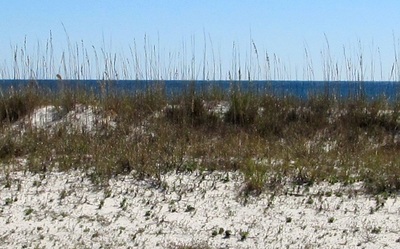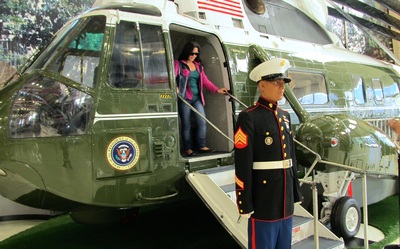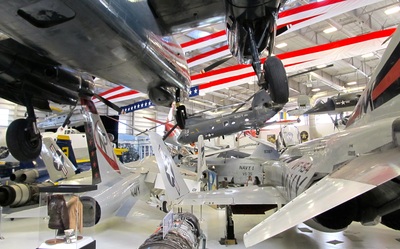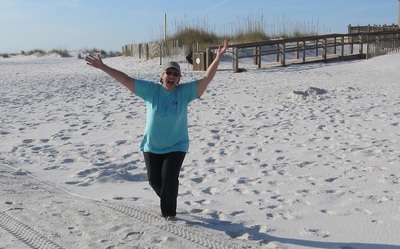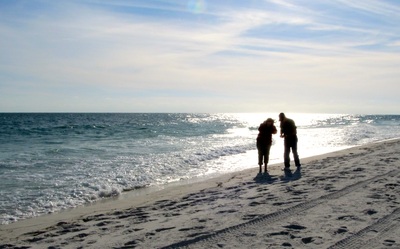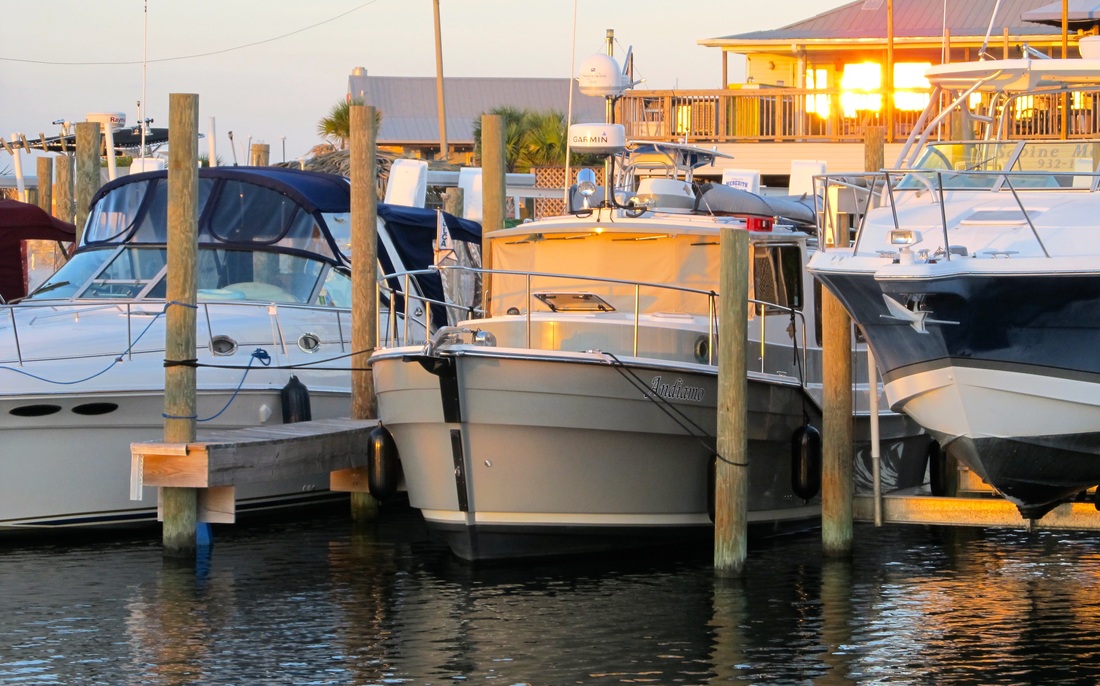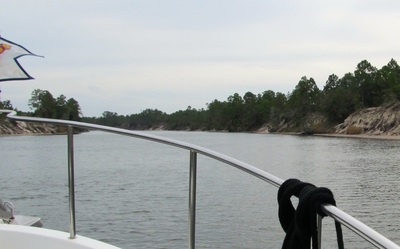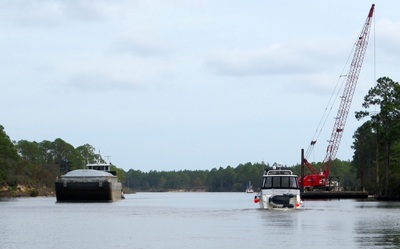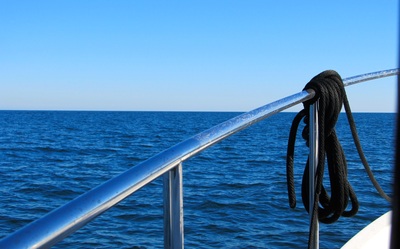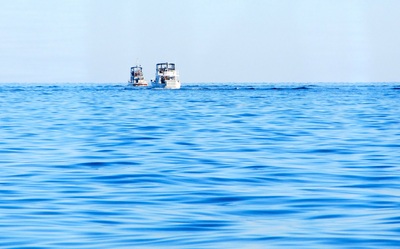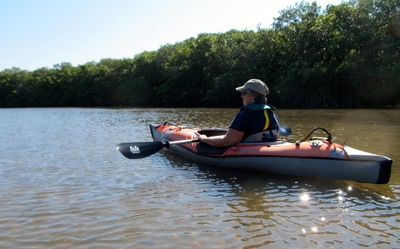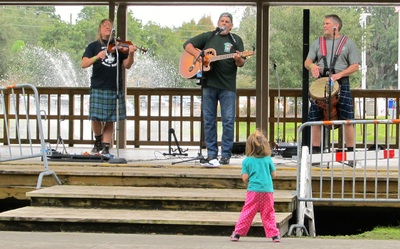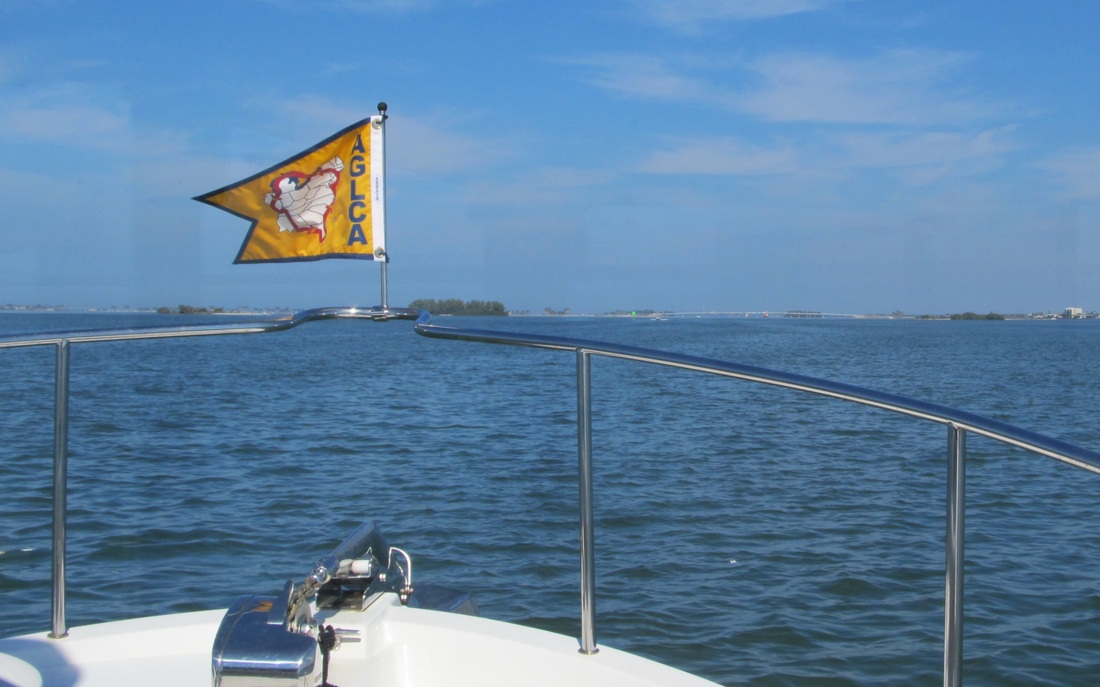heading east to stage for the southward crossing of the Gulf
Friday-Sunday, October 31-November 2: THREE DAYS IN ORANGE BEACH, ALABAMA
The morning at Mobile Bay was clear, cool and the water was flat. The weather forecast called for a cold front to come through the region in the evening with winds gusting to the mid-30’s and sustained winds in the mid-20’s on Saturday that would kick up Mobile Bay. If we were going to move on, the time had come.
Andiamo traveled south with a light north wind and an ebbing tide that provided a gentle push down Mobile Bay for 23 miles to the Gulf Intracoastal Waterway (ICW) and we were back to the slalom course of red and green markers on poles. The ICW took the tug to the east and into the Alabama Canal, a ditch that connects Mobile Bay to Wolf Bay, and where the highway bridge crosses the canal, Andiamo stopped for lunch at Lulu’s. This restaurant is owned by Lucy Buffett, the sister of Jimmy Buffett, and is a must-stop for visitors. We split an order of Maui-Maui tacos, had the local beer, bought hats and t-shirts, and enjoyed the coastal vibe.
The preferred destination was an anchorage at one of the nearly bayous but a marina was necessary to ride out the coming cold front. Orange Beach Marina was wooing loopers with cheap moorage, free power and a courtesy car and though it was a bit out of the way and off of the ICW, it was chosen. The path to the marina provided an up close and personal look at the condos, the beach houses, and the docks with the 45-foot sportfishing boats under covered moorage. However, there were very few people. November is the beginning of the slow season on the gulf and it continues into March and ends with spring break.
The marina was small and is a tightly designed home to a fleet of privately owned sportfishing boats; the ones that were dreaded because of the wakes they create. We had frequently spoken about how awful these boats are. Being in the marina was being in the lair of the enemy. But, Andiamo found a protected slip that would serve us well for the next three days. The staff was nice, friendly, bored and helpful. With three courtesy cars available and no other transient boaters, a car was always available and with no limits.
The wind blew and gusted throughout the evening but had little effect on Andiamo. The temperature dropped into the mid-40’s, requiring the heaviest blanket at night, the cabin heater in the morning and evening and layers of coats during the next day.
On Saturday, Laurie awoke with a nasty cold that would keep her down most of the day. The morning was spent on billable work hours, another part of the transition of going back to the Pacific Northwest universe, and working on a book project that is nearly complete. We took a drive around Orange Beach and the state beach that is on the gulf where we watched a photo shoot with a Santa in beach clothing. The day was closed with a quiet evening and light dinner.
Sunday morning and the clocks were set back an hour. Sunrise is now at 0600 hours but the day is dark at 5 PM. After showers and breakfast, Laurie was feeling better and we went to an Episcopal church in nearby Gulf Shores. Being with the residents, hearing about their events and plans, and feeling welcomed, made a deeper connection and enriched the adventure; cruising is more than just clicking away mileage and checking off destinations.
Laurie stayed on the boat for the afternoon to rest and recover and I took the courtesy car to the National Naval Aviation Museum at the Pensacola naval air station. This museum is new and huge with a collection of aircraft going back to the early 1900’s. The take-away was the amazing stories of courage and perseverance through wars and exploration. The serendipity was learning that Ken and Pauline from Shipperly were staying at a nearby marina. The courtesy car took us to them and we enjoyed a great dinner and conversation.
The morning at Mobile Bay was clear, cool and the water was flat. The weather forecast called for a cold front to come through the region in the evening with winds gusting to the mid-30’s and sustained winds in the mid-20’s on Saturday that would kick up Mobile Bay. If we were going to move on, the time had come.
Andiamo traveled south with a light north wind and an ebbing tide that provided a gentle push down Mobile Bay for 23 miles to the Gulf Intracoastal Waterway (ICW) and we were back to the slalom course of red and green markers on poles. The ICW took the tug to the east and into the Alabama Canal, a ditch that connects Mobile Bay to Wolf Bay, and where the highway bridge crosses the canal, Andiamo stopped for lunch at Lulu’s. This restaurant is owned by Lucy Buffett, the sister of Jimmy Buffett, and is a must-stop for visitors. We split an order of Maui-Maui tacos, had the local beer, bought hats and t-shirts, and enjoyed the coastal vibe.
The preferred destination was an anchorage at one of the nearly bayous but a marina was necessary to ride out the coming cold front. Orange Beach Marina was wooing loopers with cheap moorage, free power and a courtesy car and though it was a bit out of the way and off of the ICW, it was chosen. The path to the marina provided an up close and personal look at the condos, the beach houses, and the docks with the 45-foot sportfishing boats under covered moorage. However, there were very few people. November is the beginning of the slow season on the gulf and it continues into March and ends with spring break.
The marina was small and is a tightly designed home to a fleet of privately owned sportfishing boats; the ones that were dreaded because of the wakes they create. We had frequently spoken about how awful these boats are. Being in the marina was being in the lair of the enemy. But, Andiamo found a protected slip that would serve us well for the next three days. The staff was nice, friendly, bored and helpful. With three courtesy cars available and no other transient boaters, a car was always available and with no limits.
The wind blew and gusted throughout the evening but had little effect on Andiamo. The temperature dropped into the mid-40’s, requiring the heaviest blanket at night, the cabin heater in the morning and evening and layers of coats during the next day.
On Saturday, Laurie awoke with a nasty cold that would keep her down most of the day. The morning was spent on billable work hours, another part of the transition of going back to the Pacific Northwest universe, and working on a book project that is nearly complete. We took a drive around Orange Beach and the state beach that is on the gulf where we watched a photo shoot with a Santa in beach clothing. The day was closed with a quiet evening and light dinner.
Sunday morning and the clocks were set back an hour. Sunrise is now at 0600 hours but the day is dark at 5 PM. After showers and breakfast, Laurie was feeling better and we went to an Episcopal church in nearby Gulf Shores. Being with the residents, hearing about their events and plans, and feeling welcomed, made a deeper connection and enriched the adventure; cruising is more than just clicking away mileage and checking off destinations.
Laurie stayed on the boat for the afternoon to rest and recover and I took the courtesy car to the National Naval Aviation Museum at the Pensacola naval air station. This museum is new and huge with a collection of aircraft going back to the early 1900’s. The take-away was the amazing stories of courage and perseverance through wars and exploration. The serendipity was learning that Ken and Pauline from Shipperly were staying at a nearby marina. The courtesy car took us to them and we enjoyed a great dinner and conversation.
Monday-Tuesday, November 3-4: TWO DAYS IN PENSACOLA BEACH, FLORIDA
We will have to adjust to the sunrise coming an hour earlier as rising at 6AM is not in our wiring. The morning was clear and cool with a fresh breeze from the east that would set the pattern for the next two days as a slow moving cold front clocked around the region. After a slow but effective pump-out with the help of a talkative and pleasant dockhand at the marina, Andiamo headed east in the mid-morning, snaking around the channel markers to resume the Intracoastal Waterway in Bayou St. John and followed the north shore of Ono Island. The ICW is separated from the Gulf of Mexico by a set of barrier islands and the route is a collection of bays, bayous, rivers and man-made channels.
Andiamo headed into the east wind, a breeze that kicked up a one-foot chop, would intensify to create white caps, and would later ease to allow the water to lay down as the tug neared its destination at Pensacola Beach. The red and green channel markers switched sides three times since the Orange Beach Marina. After a narrow cut, the tug entered Santa Rosa Sound with the sprawling Naval Air Station at Pensacola on the north side of the sound and the Gulf Islands National Seashore on the south shore. We looked at an anchorage but decided it was too windy and the wind was forecasted to last for at least another day.
Laurie had found an acceptable marina option on the junction of a state highway bridge and Santa Rosa Island at Pensacola Beach. The Sabine Marina was in the heart of the tourist area with condo skyscrapers, sportfishing charters and rows of shops and restaurants. If this were the high season, we would pass on the crowds, the noise and the traffic. But in this low season, the region was quiet and nearly empty though the bars still advertised discounted drinks from 9 AM to 1 PM and free drinks on Wednesday nights from 10 PM to 1 AM.
Andiamo arrived in the early afternoon after traveling 28 miles.
The bikes took us on a long exploration of the island, out to the edge of the condos and where the national seashore started. We walked the brilliant white sand beach that felt like sugar between toes due to the high quartzite content. Laurie yelped with delight at the shells and treasures she discovered. The easterly breeze had kicked up the surf that closed the beaches but made great scenery. We watched the sunset from Andiamo’s cockpit and enjoyed the feeling of a warm breeze.
The next day brought another clear day and the morning temperature was in the low 60’s but the wind was brisk with higher gusts. There was a contradiction between what the wind stations were reporting and what we were seeing and feeling. The wind stations reported single digit winds up the 30 miles of Santa Rosa Sound but the wind felt stronger, like in the mid-teens, with gusts to the 20’s, and a look at the sound showed a flurry of white caps as far as the could see. We opted to wait and see if the wind would lie down as the day warmed.
It was not to be. Noon was our last opportunity to leave and make the destination at Fort Walton that was 36 miles away before the sunset at 5 PM. Instead, we had a pre-birthday lunch for Laurie at a nice restaurant that was doing its share of promoting alcohol abuse with two-for- one well drinks but the food was great. Afterwards, we streamed an episode of “Scandal” as we were behind. Doing this adventure means not staying up to date with the culture of the media; something that was missed for a moment, but was not thought of again. The media is a habit and a time-sink, both of which we have done nicely without. We were starting the transition of being home. Laurie did another walk on the beach; her very favorite thing in life and I worked on a book project. We had a light dinner as the wind eased, changed directions and built to a fresh breeze.
We will have to adjust to the sunrise coming an hour earlier as rising at 6AM is not in our wiring. The morning was clear and cool with a fresh breeze from the east that would set the pattern for the next two days as a slow moving cold front clocked around the region. After a slow but effective pump-out with the help of a talkative and pleasant dockhand at the marina, Andiamo headed east in the mid-morning, snaking around the channel markers to resume the Intracoastal Waterway in Bayou St. John and followed the north shore of Ono Island. The ICW is separated from the Gulf of Mexico by a set of barrier islands and the route is a collection of bays, bayous, rivers and man-made channels.
Andiamo headed into the east wind, a breeze that kicked up a one-foot chop, would intensify to create white caps, and would later ease to allow the water to lay down as the tug neared its destination at Pensacola Beach. The red and green channel markers switched sides three times since the Orange Beach Marina. After a narrow cut, the tug entered Santa Rosa Sound with the sprawling Naval Air Station at Pensacola on the north side of the sound and the Gulf Islands National Seashore on the south shore. We looked at an anchorage but decided it was too windy and the wind was forecasted to last for at least another day.
Laurie had found an acceptable marina option on the junction of a state highway bridge and Santa Rosa Island at Pensacola Beach. The Sabine Marina was in the heart of the tourist area with condo skyscrapers, sportfishing charters and rows of shops and restaurants. If this were the high season, we would pass on the crowds, the noise and the traffic. But in this low season, the region was quiet and nearly empty though the bars still advertised discounted drinks from 9 AM to 1 PM and free drinks on Wednesday nights from 10 PM to 1 AM.
Andiamo arrived in the early afternoon after traveling 28 miles.
The bikes took us on a long exploration of the island, out to the edge of the condos and where the national seashore started. We walked the brilliant white sand beach that felt like sugar between toes due to the high quartzite content. Laurie yelped with delight at the shells and treasures she discovered. The easterly breeze had kicked up the surf that closed the beaches but made great scenery. We watched the sunset from Andiamo’s cockpit and enjoyed the feeling of a warm breeze.
The next day brought another clear day and the morning temperature was in the low 60’s but the wind was brisk with higher gusts. There was a contradiction between what the wind stations were reporting and what we were seeing and feeling. The wind stations reported single digit winds up the 30 miles of Santa Rosa Sound but the wind felt stronger, like in the mid-teens, with gusts to the 20’s, and a look at the sound showed a flurry of white caps as far as the could see. We opted to wait and see if the wind would lie down as the day warmed.
It was not to be. Noon was our last opportunity to leave and make the destination at Fort Walton that was 36 miles away before the sunset at 5 PM. Instead, we had a pre-birthday lunch for Laurie at a nice restaurant that was doing its share of promoting alcohol abuse with two-for- one well drinks but the food was great. Afterwards, we streamed an episode of “Scandal” as we were behind. Doing this adventure means not staying up to date with the culture of the media; something that was missed for a moment, but was not thought of again. The media is a habit and a time-sink, both of which we have done nicely without. We were starting the transition of being home. Laurie did another walk on the beach; her very favorite thing in life and I worked on a book project. We had a light dinner as the wind eased, changed directions and built to a fresh breeze.
WEDNESDAY-THURSDAY, NOVEMBER 5-6: TWO DAYS TO PANAMA CITY/ST. ANDREWS
Sunrise brought clear skies and calm waters and yet autumn was in the air. Back in salt water meant that the tug’s windows need a daily removal of dried salt. Andiamo slipped out of the marina an hour later and waited at the causeway for a tow to clear the span before heading east. The fresh easterly breeze that traveled the length of the 30-mile long bay created a medium chop. After weeks of dead flat calm water on the inland river system, there was a trace of discomfort with this chop, but that evaporated as we continued on.
Our comfort zone for cruising is always adjusting and is most influenced by the most recent conditions. After weeks of Lake Huron and Lake Michigan, we were comfortable with 2-foot swells. Being on the Gulf Intracoastal Waterway means transiting large and shallow bays where a breeze in the mid-teens can kick up the water. Also, Andiamo is back to dealing with tides and the associated current and though the tidal change is less than two feet and the current is maybe one knot in strength, the combination of fetch, shallow water and wind over current can create conditions that need to be respected. Watching the weather forecasts was necessary to identify the windows to travel.
Andiamo followed the red and green channel markers and proceeded at 8 MPH for most of the bay and did power up for 45 minutes to cover some miles. The Santa Rosa Sound is about 1 ½ miles wide and the channel is 10 to 20 feet deep. The barrier island that is between the gulf and us is mostly undeveloped, except for the occasional military structure, communication tower, or park building, and is often sand dunes. The storms have their way and mankind has to adapt to it. Past Navarre, the ICW narrowed and the channel swung from one shore to another as it skirted the shoals.
Laurie had chosen Fort Walton Beach and their free town dock as the destination and Andiamo arrived there in the late morning having traveled 35 miles.
Free docks are generally interesting because of the wide spectrum people that are encountered. The town works at preventing boats from staying more than a night or two. Just beyond the dock were three sailboats swinging on anchors. The boats were nearly derelict, probably barely operational, and one male who looked to be nearly homeless was on each one. They were not frightening or alarming and we did not feel uncomfortable. An unsecured dock means that people will come and look over the tug. Again, this was all acceptable and reasonable measures were done to provide for the security of the possessions inside the cabin.
We discovered a 15-amp outlet on the slip and plugged in to charge the phones and computers and keep the water hot; another example of the unexpected blessing that makes the adventure interesting. Laurie followed the directions on the dock and called the city manager’s office that provided information about the area and where to go. They said the police department would receive the information about the tug and to expect them to come by.
The bikes quickly took us into a downtown that was rebuilding. Restaurants and shops were a block or two a way and we rode on into the residential area, past a strip mall that had a Publix Market, and followed the road along the shore for a mile. The houses were a mix of older, established middle-class homes on bigger lots and newer, high-end homes and new multi-story condos that were being built. This resembled San Diego’s Point Loma neighborhood in the 1970’s before it became all high-end. Provisioning was done at the Publix.
When we came back, a 28 foot cruiser from Texas had taken the slip next Andiamo and we met Bill and Betty who have cruised these waters for years, written articles, and were headed to Florida.
Being Laurie’s birthday, we enjoyed a fabulous dinner at Ally’s Bistro. Back at the tug, the special bakery treats made for a birthday dessert and the evening was closed with birthday wishes from the family and the movie, “When Harry Met Sally.”
Sunrise brought clear skies and calm waters and yet autumn was in the air. Back in salt water meant that the tug’s windows need a daily removal of dried salt. Andiamo slipped out of the marina an hour later and waited at the causeway for a tow to clear the span before heading east. The fresh easterly breeze that traveled the length of the 30-mile long bay created a medium chop. After weeks of dead flat calm water on the inland river system, there was a trace of discomfort with this chop, but that evaporated as we continued on.
Our comfort zone for cruising is always adjusting and is most influenced by the most recent conditions. After weeks of Lake Huron and Lake Michigan, we were comfortable with 2-foot swells. Being on the Gulf Intracoastal Waterway means transiting large and shallow bays where a breeze in the mid-teens can kick up the water. Also, Andiamo is back to dealing with tides and the associated current and though the tidal change is less than two feet and the current is maybe one knot in strength, the combination of fetch, shallow water and wind over current can create conditions that need to be respected. Watching the weather forecasts was necessary to identify the windows to travel.
Andiamo followed the red and green channel markers and proceeded at 8 MPH for most of the bay and did power up for 45 minutes to cover some miles. The Santa Rosa Sound is about 1 ½ miles wide and the channel is 10 to 20 feet deep. The barrier island that is between the gulf and us is mostly undeveloped, except for the occasional military structure, communication tower, or park building, and is often sand dunes. The storms have their way and mankind has to adapt to it. Past Navarre, the ICW narrowed and the channel swung from one shore to another as it skirted the shoals.
Laurie had chosen Fort Walton Beach and their free town dock as the destination and Andiamo arrived there in the late morning having traveled 35 miles.
Free docks are generally interesting because of the wide spectrum people that are encountered. The town works at preventing boats from staying more than a night or two. Just beyond the dock were three sailboats swinging on anchors. The boats were nearly derelict, probably barely operational, and one male who looked to be nearly homeless was on each one. They were not frightening or alarming and we did not feel uncomfortable. An unsecured dock means that people will come and look over the tug. Again, this was all acceptable and reasonable measures were done to provide for the security of the possessions inside the cabin.
We discovered a 15-amp outlet on the slip and plugged in to charge the phones and computers and keep the water hot; another example of the unexpected blessing that makes the adventure interesting. Laurie followed the directions on the dock and called the city manager’s office that provided information about the area and where to go. They said the police department would receive the information about the tug and to expect them to come by.
The bikes quickly took us into a downtown that was rebuilding. Restaurants and shops were a block or two a way and we rode on into the residential area, past a strip mall that had a Publix Market, and followed the road along the shore for a mile. The houses were a mix of older, established middle-class homes on bigger lots and newer, high-end homes and new multi-story condos that were being built. This resembled San Diego’s Point Loma neighborhood in the 1970’s before it became all high-end. Provisioning was done at the Publix.
When we came back, a 28 foot cruiser from Texas had taken the slip next Andiamo and we met Bill and Betty who have cruised these waters for years, written articles, and were headed to Florida.
Being Laurie’s birthday, we enjoyed a fabulous dinner at Ally’s Bistro. Back at the tug, the special bakery treats made for a birthday dessert and the evening was closed with birthday wishes from the family and the movie, “When Harry Met Sally.”
The next day’s sunrise was over the barrier island and the town of Destin. The morning was warm, the skies were partly cloudy as a weak cold front was approaching that could bring a few rain showers later in the day. The water was dead calm and reflected the clouds and the light like a huge mirror. Bill was taking photos and before we left, they were walking to Publix. We had the same destination of St. Andrews Marina in Panama City that was 64 miles away. Bill and Betty would later catch up to Andiamo and meet us at the marina as they cruise at 20 MPH.
Andiamo entered the Choctawhatchee Bay and would spend most of the morning traveling 30 miles on a bay that was two miles wide. At the east end, dolphins and pelicans were feeding where the man-made channel was cut through the cypress swamp that connected the Chockawatchee to West Bay. This 20 mile long cut is about 200 feet wide with 20 to 40 foot high sand bluffs on each side that were eroding into the channel. The guidebook called this the “Grand Canyon.” This swamp had tall pines, the occasional side channel to the rare dock or house. The map showed a road or two in hundreds of square miles of swamp.
The cruising was delightful and interesting with the changing scenery, the wildlife, and the occasional fisherman, cruising boat or towboat pushing a barge. Near the entrance to West Bay, the broad flat tail of the first manatee was seen slowing swimming in the shallows. West Bay is huge, being broad and long and the dredged channel separated the cruising boats from the pairs of commercial fisherman in their flat bottom boats that were pulling up nets.
Andiamo arrived at St. Andrews Marina at 2:30 PM and had traveled 64 miles.
Next to Andiamo was a Great Harbor N37 and Joe and Punk who have done the loop three times, lived aboard for 7 years and have cruised over 30,000 miles. Joe is a frequent and thoughtful contributor to the AGLCA member’s forum. We immediately liked them and accepted their invitation for dinner aboard their boat. The evening was spent listening to the wisdom and sharing stories.
Joe and Punk are an example of another subset of loopers. As full time live-a-boards, their boat is their only home and, as they said, “We are not camping.” In that phrase is an unspoken acceptance of additional complexities of the systems in their boat; more equipment, electrical complexities to have the conveniences they want, more storage, and a desired redundancy in key functions. Some of their wisdom was; a second stateroom is rarely used for people - it is used for storage and would be better used for systems, a flybridge is not necessary when the helm station is well engineered, and the inland rivers are great cruising areas.
Andiamo entered the Choctawhatchee Bay and would spend most of the morning traveling 30 miles on a bay that was two miles wide. At the east end, dolphins and pelicans were feeding where the man-made channel was cut through the cypress swamp that connected the Chockawatchee to West Bay. This 20 mile long cut is about 200 feet wide with 20 to 40 foot high sand bluffs on each side that were eroding into the channel. The guidebook called this the “Grand Canyon.” This swamp had tall pines, the occasional side channel to the rare dock or house. The map showed a road or two in hundreds of square miles of swamp.
The cruising was delightful and interesting with the changing scenery, the wildlife, and the occasional fisherman, cruising boat or towboat pushing a barge. Near the entrance to West Bay, the broad flat tail of the first manatee was seen slowing swimming in the shallows. West Bay is huge, being broad and long and the dredged channel separated the cruising boats from the pairs of commercial fisherman in their flat bottom boats that were pulling up nets.
Andiamo arrived at St. Andrews Marina at 2:30 PM and had traveled 64 miles.
Next to Andiamo was a Great Harbor N37 and Joe and Punk who have done the loop three times, lived aboard for 7 years and have cruised over 30,000 miles. Joe is a frequent and thoughtful contributor to the AGLCA member’s forum. We immediately liked them and accepted their invitation for dinner aboard their boat. The evening was spent listening to the wisdom and sharing stories.
Joe and Punk are an example of another subset of loopers. As full time live-a-boards, their boat is their only home and, as they said, “We are not camping.” In that phrase is an unspoken acceptance of additional complexities of the systems in their boat; more equipment, electrical complexities to have the conveniences they want, more storage, and a desired redundancy in key functions. Some of their wisdom was; a second stateroom is rarely used for people - it is used for storage and would be better used for systems, a flybridge is not necessary when the helm station is well engineered, and the inland rivers are great cruising areas.
Friday, November 7: A DAY IN PANAMA CITY AND ST. ANDREWS
After breakfast we walked the small Main Street, city park and residential neighborhoods. Later, the bikes were set up and the scenic route was taken to downtown Panama City where the marina and business district was explored. On the way back, we chose a route through the older residential area and discovered well maintain homes that were only blocks from the water and were very affordable. The huge live oaks on both sides of the city streets provided an effective canopy that nearly covered the whole street providing shade and great scenery.
More looper boats arrived in the late afternoon; some we had seen before and others were new to us. The loopers were pushing toward Apalachicola and Carrabelle to stage and wait for a weather window to cross the Gulf of Mexico to Florida’s west coast.
The evening was closed with a planning discussion on the options before us.
After breakfast we walked the small Main Street, city park and residential neighborhoods. Later, the bikes were set up and the scenic route was taken to downtown Panama City where the marina and business district was explored. On the way back, we chose a route through the older residential area and discovered well maintain homes that were only blocks from the water and were very affordable. The huge live oaks on both sides of the city streets provided an effective canopy that nearly covered the whole street providing shade and great scenery.
More looper boats arrived in the late afternoon; some we had seen before and others were new to us. The loopers were pushing toward Apalachicola and Carrabelle to stage and wait for a weather window to cross the Gulf of Mexico to Florida’s west coast.
The evening was closed with a planning discussion on the options before us.
APALACHICOLA AND CARRABELLE
Saturday, November 8: AN ENCHANTING CRUISE TO APALACHICOLA
A cloudy, cool and breezy day greeted Andiamo and the diesel cabin heater was needed for the first hour. Andiamo slipped away from the dock at 7 AM for the 64-mile trip to Apalachicola. Ahead of us were two looper boats and soon there were three more behind us.
This would be an enchanting cruising day, showing the variety and magic of this area. Nearly every turn and bend of the ICW would present a wonderful scene. The miles clicked on by for an easy cruising day.
After St. Andrews marina, Andiamo met a Coast Guard cutter coming off the gulf, probably from the search and rescue mission for the F-16 jet that had crashed into the gulf several days earlier. The Panama City marina was passed and the channel markers wound their way down West Bay, past Farmsdale Bayou and Lathrop Bayou. Dolphins were a frequent companion as they are at the top of the food chain and worked in pairs or small groups to feed.
At Wetappo Creek, the ICW leaves the bay and the next 40 or so miles, is a narrow 200 to 300 feet wide river that winds through cypress swamp with junctions to streams, oxbows and the occasional small lake. The scenery changes with the vegetation and the topography. Miles of marsh, like in Georgia, were in the foreground with towering pines in the background. Then, the marsh would fade away and the pines, live oak, palms and cypress would be to the water’s edge. Higher banks would be cut away by the water, leaving the trees leaning steeply toward the water. A remnant of a forest fire was cruised through as the black and stark skeletons of the trees that still stood were silhouetted against the sky.
Halfway through this trip came the small community of White City that also marked the return to Eastern Standard Time and we gained an hour on sunlight. Lake Wimico was a unique challenge as the channel was dead straight, narrow, with the channel markers far a part and the water was very shallow outside of the channel. The Jackson River merged with the Apalachicola River to create a wide and vibrant delta of marine life and a very rich oyster habitat.
Andiamo’s destination was the Water Hotel and Marina and arrived at 4:30 PM having traveled for 8 hours and 64 miles. The turn to the marina was not well marked and the tug scraped the sea life off its hull in the mud. The other boaters were helpful in bringing the tug in to the slip as the current had other plans.
We walked the very interesting small town and followed the recommendation of the hotel staff and had dinner at Papa Joe’s where Laurie had baked oysters and I had a Po’ Boy shrimp sandwich. Back at the marina, we met the owners of a Ranger 27 who had just taken delivery of it.
A cloudy, cool and breezy day greeted Andiamo and the diesel cabin heater was needed for the first hour. Andiamo slipped away from the dock at 7 AM for the 64-mile trip to Apalachicola. Ahead of us were two looper boats and soon there were three more behind us.
This would be an enchanting cruising day, showing the variety and magic of this area. Nearly every turn and bend of the ICW would present a wonderful scene. The miles clicked on by for an easy cruising day.
After St. Andrews marina, Andiamo met a Coast Guard cutter coming off the gulf, probably from the search and rescue mission for the F-16 jet that had crashed into the gulf several days earlier. The Panama City marina was passed and the channel markers wound their way down West Bay, past Farmsdale Bayou and Lathrop Bayou. Dolphins were a frequent companion as they are at the top of the food chain and worked in pairs or small groups to feed.
At Wetappo Creek, the ICW leaves the bay and the next 40 or so miles, is a narrow 200 to 300 feet wide river that winds through cypress swamp with junctions to streams, oxbows and the occasional small lake. The scenery changes with the vegetation and the topography. Miles of marsh, like in Georgia, were in the foreground with towering pines in the background. Then, the marsh would fade away and the pines, live oak, palms and cypress would be to the water’s edge. Higher banks would be cut away by the water, leaving the trees leaning steeply toward the water. A remnant of a forest fire was cruised through as the black and stark skeletons of the trees that still stood were silhouetted against the sky.
Halfway through this trip came the small community of White City that also marked the return to Eastern Standard Time and we gained an hour on sunlight. Lake Wimico was a unique challenge as the channel was dead straight, narrow, with the channel markers far a part and the water was very shallow outside of the channel. The Jackson River merged with the Apalachicola River to create a wide and vibrant delta of marine life and a very rich oyster habitat.
Andiamo’s destination was the Water Hotel and Marina and arrived at 4:30 PM having traveled for 8 hours and 64 miles. The turn to the marina was not well marked and the tug scraped the sea life off its hull in the mud. The other boaters were helpful in bringing the tug in to the slip as the current had other plans.
We walked the very interesting small town and followed the recommendation of the hotel staff and had dinner at Papa Joe’s where Laurie had baked oysters and I had a Po’ Boy shrimp sandwich. Back at the marina, we met the owners of a Ranger 27 who had just taken delivery of it.
Sunday, November 9: A DAY IN APALACHICOLA
The next day, after showers, breakfast and boat cleaning chores, the walk to Trinity Episcopal Church was easy. With to time to spare before the service, the Gorrie State Museum was explored. Dr. Gorrie came to Apalachicola in the mid 1800’s, right out of medical school because of an interest in yellow fever and malaria; diseases that ravaged the southeast coast every year. His pursuit to find an effective treatment that included putting patients in a cooler environment resulted in the discovery and patent of the process of refrigeration and air conditioning. The take-a-ways: Gorrie knew he was ahead of his time and though he invested his entire life savings, he did not live long enough to benefit financially. Also, he was fought at every turn by the ice industry; another example of how industry will fight innovation and change at every turn to protect their self-interests. Good ideas will die at the hand of greed and selflessness.
The serendipity: the world changed due to what happened in little Apalachicola.
The church service was great, the rector was inspiring and the people were friendly. I got ideas that can be applied back home and that is one of the gifts of this adventure.
After a wonderful lunch in a local café and exploring the shops that were open on a Sunday, we decided to move to the town of Carrabelle on Monday that was 30 miles away to stage for crossing the Gulf of Mexico. Fuel was transferred from the auxiliary fuel tank to the main tank as a step to reduce the weight of the fuel for the road trip back to Seattle.
Crossing the Gulf of Mexico is one of the significant parts of this adventure. Loopers do this 150 mile plus trip in one of two ways: one point-to-point trip that takes 20 plus hours and means traveling all night or doing a three day trip to the small towns in Florida’s Big Bend but the water is very shallow. We wanted to do both but the weather window to cross is approaching and the window is maybe three days long. November typically has only 6 days of crossing conditions and these windows can be very far a part. We knew a looper who had waited 25 days to cross the gulf. The weather window was predicted to start Monday, November 10. We decided to do the point-to-point trip, from Carrabelle to Tarpon Springs, and travel with a small group of boats, as there is safety in numbers. Cruising at night and running for more than 12 hours would be new for us.
Mid-afternoon and we had a chance encounter with other loopers that turned into a meeting about the crossing. The seven boats were all interested in going to the same destination of Tarpon Springs, leaving Tuesday morning, going the same speed of 8 MPH or 7 knots and agreed to meet Monday afternoon at the anchorage at the west end of Dog Island. Two of the boats had made the crossing before. This was another serendipity of finding like-minded boaters.
The next day, after showers, breakfast and boat cleaning chores, the walk to Trinity Episcopal Church was easy. With to time to spare before the service, the Gorrie State Museum was explored. Dr. Gorrie came to Apalachicola in the mid 1800’s, right out of medical school because of an interest in yellow fever and malaria; diseases that ravaged the southeast coast every year. His pursuit to find an effective treatment that included putting patients in a cooler environment resulted in the discovery and patent of the process of refrigeration and air conditioning. The take-a-ways: Gorrie knew he was ahead of his time and though he invested his entire life savings, he did not live long enough to benefit financially. Also, he was fought at every turn by the ice industry; another example of how industry will fight innovation and change at every turn to protect their self-interests. Good ideas will die at the hand of greed and selflessness.
The serendipity: the world changed due to what happened in little Apalachicola.
The church service was great, the rector was inspiring and the people were friendly. I got ideas that can be applied back home and that is one of the gifts of this adventure.
After a wonderful lunch in a local café and exploring the shops that were open on a Sunday, we decided to move to the town of Carrabelle on Monday that was 30 miles away to stage for crossing the Gulf of Mexico. Fuel was transferred from the auxiliary fuel tank to the main tank as a step to reduce the weight of the fuel for the road trip back to Seattle.
Crossing the Gulf of Mexico is one of the significant parts of this adventure. Loopers do this 150 mile plus trip in one of two ways: one point-to-point trip that takes 20 plus hours and means traveling all night or doing a three day trip to the small towns in Florida’s Big Bend but the water is very shallow. We wanted to do both but the weather window to cross is approaching and the window is maybe three days long. November typically has only 6 days of crossing conditions and these windows can be very far a part. We knew a looper who had waited 25 days to cross the gulf. The weather window was predicted to start Monday, November 10. We decided to do the point-to-point trip, from Carrabelle to Tarpon Springs, and travel with a small group of boats, as there is safety in numbers. Cruising at night and running for more than 12 hours would be new for us.
Mid-afternoon and we had a chance encounter with other loopers that turned into a meeting about the crossing. The seven boats were all interested in going to the same destination of Tarpon Springs, leaving Tuesday morning, going the same speed of 8 MPH or 7 knots and agreed to meet Monday afternoon at the anchorage at the west end of Dog Island. Two of the boats had made the crossing before. This was another serendipity of finding like-minded boaters.
Crossing the Gulf of Mexico
Monday, November 10: TO CARRABELLE
This would be one of those days where it would turn out way different from what was planned or hoped for; a day that would unexpectedly challenge us on several fronts. Doing the loop means that some days will include overcoming and adapting to the unexpected.
Sunrise brought clear skies and still winds and another morning where the cabin heater would run for an hour. Andiamo backed out of the slip an hour later for the 30 mile run to Carrabelle. The tug ran with the current down the Apalachicola River until it emptied into St. George Sound. The route was plain to see and easy to follow as the red and green channel markers provided the only route to transit this shallow sound that is separated from the Gulf of Mexico by St. George Island.
Boats were moving to Carrabelle and the nearby anchorage at Dog Island as the stepping off place to cross the Gulf of Mexico. So, Andiamo was not alone in the narrow and nearly perfectly straight channel. The VHF radio was carrying the chatter between the boats about the NOAA and the commercial sources about their wind and sea predictions. 24 hours earlier, the prediction was that Monday would be a marginal day, Tuesday was good and Wednesday was looking good. We had decided to cross on the Tuesday and therefore spend the night in Carrabelle, explore the sights, and get our head into doing a 20-hour cruise that included running all night.
As Andiamo entered the channel to Carrabelle, all of that changed when the updated forecasts were released; Monday was the best day, Tuesday was marginal, and Wednesday was iffier. The weather was changing. Then, the weather window would be closed for at least a week.
The decision was made to seize the opportunity and do the crossing today. The 8 MPH cruisers would be meeting at the last channel buoy that meets the gulf at 2 PM. Andiamo had two hours to get to the marina, fuel up and pump-out, and get to the buoy. What was going to be a laid back afternoon and spent mentally gearing up was now engaged into all-out preparations.
Andiamo took more fuel than expected and we were glad to have the comfort of a full tank. Once, I had bought only enough fuel to get back to a marina, as I did not want to carry the extra weight on the boat’s trailer. The estimate was wrong because we traveled too fast and the boat ran of fuel 100 yards from the dock. The lessons learned from experience are the ones that last.
We were anxious about the crossing and that anxiety spilled over to concerns about the pump-out and worries that the fickled float switch on the main bilge would act up and cause the pump to run continuously and perhaps burnout. There was not time to switch out it with the spare that Andiamo carried.
When we thought we had time for a walk, the phone rang and the time able had been moved up. The acknowledged group leader that Andiamo was going with had left the marina earlier than expected and we had to scurry to get underway and after the no wake zone, Andiamo was powered up to its fast cruising speed to make the rendezvous with four other boats.
This would be one of those days where it would turn out way different from what was planned or hoped for; a day that would unexpectedly challenge us on several fronts. Doing the loop means that some days will include overcoming and adapting to the unexpected.
Sunrise brought clear skies and still winds and another morning where the cabin heater would run for an hour. Andiamo backed out of the slip an hour later for the 30 mile run to Carrabelle. The tug ran with the current down the Apalachicola River until it emptied into St. George Sound. The route was plain to see and easy to follow as the red and green channel markers provided the only route to transit this shallow sound that is separated from the Gulf of Mexico by St. George Island.
Boats were moving to Carrabelle and the nearby anchorage at Dog Island as the stepping off place to cross the Gulf of Mexico. So, Andiamo was not alone in the narrow and nearly perfectly straight channel. The VHF radio was carrying the chatter between the boats about the NOAA and the commercial sources about their wind and sea predictions. 24 hours earlier, the prediction was that Monday would be a marginal day, Tuesday was good and Wednesday was looking good. We had decided to cross on the Tuesday and therefore spend the night in Carrabelle, explore the sights, and get our head into doing a 20-hour cruise that included running all night.
As Andiamo entered the channel to Carrabelle, all of that changed when the updated forecasts were released; Monday was the best day, Tuesday was marginal, and Wednesday was iffier. The weather was changing. Then, the weather window would be closed for at least a week.
The decision was made to seize the opportunity and do the crossing today. The 8 MPH cruisers would be meeting at the last channel buoy that meets the gulf at 2 PM. Andiamo had two hours to get to the marina, fuel up and pump-out, and get to the buoy. What was going to be a laid back afternoon and spent mentally gearing up was now engaged into all-out preparations.
Andiamo took more fuel than expected and we were glad to have the comfort of a full tank. Once, I had bought only enough fuel to get back to a marina, as I did not want to carry the extra weight on the boat’s trailer. The estimate was wrong because we traveled too fast and the boat ran of fuel 100 yards from the dock. The lessons learned from experience are the ones that last.
We were anxious about the crossing and that anxiety spilled over to concerns about the pump-out and worries that the fickled float switch on the main bilge would act up and cause the pump to run continuously and perhaps burnout. There was not time to switch out it with the spare that Andiamo carried.
When we thought we had time for a walk, the phone rang and the time able had been moved up. The acknowledged group leader that Andiamo was going with had left the marina earlier than expected and we had to scurry to get underway and after the no wake zone, Andiamo was powered up to its fast cruising speed to make the rendezvous with four other boats.
At 1:30 PM, Andiamo passed the last buoy; headed into the Gulf of Mexico, and the Garmin chartplotter and autopilot were programmed to go to the number 4 red channel marker at Tarpon Springs that was 160 miles away and to the southeast. The route would be straight and across 50 to 60 feet of water. The water would become shallower two or three hours before the destination and caused the concern of finding the floating markers of crab traps. The shoreline would not be visible for 90% of the trip. The wind forecast was for winds on our stern that would peak in the mid-teens and the swell forecast was for 1 to 2 foot swells for 80 miles.
For the entire trip the swells would be at Andiamo’s stern and at the port side corner. The tug would quarter the swells for the next 20 hours. The autopilot would work very hard to maintain the 136-degree heading, as the water pushed the tug on the corner and cause it to go back and forth.
The tug was traveling with a 36- foot Grand Banks tri-cabin trawler, a 35-foot Mainship sedan trawler, a 40-foot Albin tri-cabin trawler and a 42-foot sundeck trawler. Two of these boats had done the crossing before. One crew had just started the loop and did not have autopilot, and another had autopilot issues that would likely cause them to hand steer much of the way. At 29 feet, we became known as the “little one.”
Other boats would leave after us. Five boats that travel at 9 miles per hour would leave two hours later and the big fast boats were leaving at 5 PM. By 3 AM, 13 boats would travel together and be spread across a four square mile area. We would find that the real work of this cruise would be maintaining a safe distance between the boats around Andiamo and the most valuable tool in doing this, was the radar.
In the late afternoon, we saw an adult sea turtle off Andiamo’s bow. Two of the boats had a school of dolphins put on a show. Two boats fished; one caught a Little Tunnie that is not good eating and the other lost their fish to a Cormorant that also emptied the spool of fishing line.
Sunset was in a cloudless sky and the whole western sky turned yellow. The sunset did not linger and there was almost no twilight. When the sun was gone, it was dark at just after 6 PM. Without visual markers and not seeing the swells, there was no anticipation of the boat’s movement but the slight rolling and pitching as the swells went under the tug was rhythmic and nearly constant. The ride was not smooth like in a protected bay, but the ride was acceptable.
The air was cool in the moderate breeze. The door on the starboard side was kept open and the white froth from the bow wave was the main color seen on the sea. For hours, the boats did not move much in relation to each other. The constant blips on the radar screen and the ever-present running lights created a feeling of safety and security. Man was not meant to be alone in times of anxiety and challenges.
The stars exploded across the sky, arcing across from the edge of the water to the other horizon. Without a moon and no lights from habitation, the number of stars was incredible. Three hour long watches were scheduled. The person starting the watch would eat as a method to stay alert. An effort was made to keep drinking but caffeine was avoided. A list of Andiamo’s gauges with the acceptable readings was made and a schedule was made to check the status of specific systems. A new combination screen was created for the chartplotter that showed the radar and the navigation chart.
For the entire trip the swells would be at Andiamo’s stern and at the port side corner. The tug would quarter the swells for the next 20 hours. The autopilot would work very hard to maintain the 136-degree heading, as the water pushed the tug on the corner and cause it to go back and forth.
The tug was traveling with a 36- foot Grand Banks tri-cabin trawler, a 35-foot Mainship sedan trawler, a 40-foot Albin tri-cabin trawler and a 42-foot sundeck trawler. Two of these boats had done the crossing before. One crew had just started the loop and did not have autopilot, and another had autopilot issues that would likely cause them to hand steer much of the way. At 29 feet, we became known as the “little one.”
Other boats would leave after us. Five boats that travel at 9 miles per hour would leave two hours later and the big fast boats were leaving at 5 PM. By 3 AM, 13 boats would travel together and be spread across a four square mile area. We would find that the real work of this cruise would be maintaining a safe distance between the boats around Andiamo and the most valuable tool in doing this, was the radar.
In the late afternoon, we saw an adult sea turtle off Andiamo’s bow. Two of the boats had a school of dolphins put on a show. Two boats fished; one caught a Little Tunnie that is not good eating and the other lost their fish to a Cormorant that also emptied the spool of fishing line.
Sunset was in a cloudless sky and the whole western sky turned yellow. The sunset did not linger and there was almost no twilight. When the sun was gone, it was dark at just after 6 PM. Without visual markers and not seeing the swells, there was no anticipation of the boat’s movement but the slight rolling and pitching as the swells went under the tug was rhythmic and nearly constant. The ride was not smooth like in a protected bay, but the ride was acceptable.
The air was cool in the moderate breeze. The door on the starboard side was kept open and the white froth from the bow wave was the main color seen on the sea. For hours, the boats did not move much in relation to each other. The constant blips on the radar screen and the ever-present running lights created a feeling of safety and security. Man was not meant to be alone in times of anxiety and challenges.
The stars exploded across the sky, arcing across from the edge of the water to the other horizon. Without a moon and no lights from habitation, the number of stars was incredible. Three hour long watches were scheduled. The person starting the watch would eat as a method to stay alert. An effort was made to keep drinking but caffeine was avoided. A list of Andiamo’s gauges with the acceptable readings was made and a schedule was made to check the status of specific systems. A new combination screen was created for the chartplotter that showed the radar and the navigation chart.
Tuesday, November 11: THE ALL NIGHT CROSSING
Running at night and time slows down. With the lack of outside visual stimulus, the tug’s gauges and the radar were checked every few seconds rather than every few minutes. The mind does not slow down and soon the imagination is filling in the void with over-thinking and wondering: what was that sound? Is something wrong? Are we too close to that boat? Is the autopilot working correctly? A look at the watch and only 5 minutes has passed. The satellite radio was used all night with Jimmy Buffet’s Margaritaville the choice because it was uplifting and sing-able.
The bilge pump float switch became an issue as the bilge pump was running all the time. The fix would be to open the engine hatch, motor down to idle and neutral and then cut the wire to the switch that was under the drive shaft. Then the pump would be turned on manually on a schedule, such as one every 30 minutes. I was serious considering doing this but that meant working in the engine compartment in the night and when the boat was pitching and rolling in the swells. The consensus was to do nothing and let the pump run. If it burned out, the second pump in the bilge would take care of any issues.
Laurie took her watch at 9 PM and I slept through most of the next three hours. About once an hour, there was a conversation on the radio and often a check of everyone’s status. Laurie saw the moon rise that was an orange ball rising out of the ink-black water, blocking out the stars, and illuminating an eastern slice of the gulf.
For 14 hours, the tug would go faster than the swells and it would surf down the face of the 2 footers. Then, the flotilla’s leader slowed down the speed to make sure that the arrival in the area of the crab pots would happen in the sunlight. By 1 AM the swells had built to 2-3 footers with an occasional 4 footer. The detail of the swells could not be seen which was good. What cannot be seen is generally not worried about.
I slept again for 90 minutes after getting off watch at 3 AM and then stayed with Laurie for the early morning watch when our bodies tell us that we should be sleeping. Though the sunrise came at 7 AM, the pre-dawn twilight created substantial visibility a half hour before. The sun’s rise was sudden, deliberate and fast.
The destination was not measured in time but in distance. 12 miles out, the first crab pot was seen in 30 feet of water. 8 miles out, land was first sighted. 5 miles out, the swells laid down to a sedate 1-foot chop. At 9:45 AM, the red number 2 buoy was met; a crossing that lasted 20 hours and 15 minutes.
At 10:15 AM, Andiamo turned at the channel marker to Tarpon Springs and formally crossed its wake that was first made on February 3.
Andiamo had traveled 200 miles since leaving Apalachicola.
An hour later, Andiamo was at the Turtle Cove Marina and we were happy to let the dock staff tie up the lines. After a tour of the facilities and the relevant parts of the nearby commercial zone by a lovely young lady from Canada, long showers were taken and a nap for the rest of afternoon. The gold AGLCA burgee was raised; the outward symbol that Andiamo hard completed the Great Loop.
Three other looper boats arrived and stories were shared. The evening was closed with a light dinner and a movie.
Running at night and time slows down. With the lack of outside visual stimulus, the tug’s gauges and the radar were checked every few seconds rather than every few minutes. The mind does not slow down and soon the imagination is filling in the void with over-thinking and wondering: what was that sound? Is something wrong? Are we too close to that boat? Is the autopilot working correctly? A look at the watch and only 5 minutes has passed. The satellite radio was used all night with Jimmy Buffet’s Margaritaville the choice because it was uplifting and sing-able.
The bilge pump float switch became an issue as the bilge pump was running all the time. The fix would be to open the engine hatch, motor down to idle and neutral and then cut the wire to the switch that was under the drive shaft. Then the pump would be turned on manually on a schedule, such as one every 30 minutes. I was serious considering doing this but that meant working in the engine compartment in the night and when the boat was pitching and rolling in the swells. The consensus was to do nothing and let the pump run. If it burned out, the second pump in the bilge would take care of any issues.
Laurie took her watch at 9 PM and I slept through most of the next three hours. About once an hour, there was a conversation on the radio and often a check of everyone’s status. Laurie saw the moon rise that was an orange ball rising out of the ink-black water, blocking out the stars, and illuminating an eastern slice of the gulf.
For 14 hours, the tug would go faster than the swells and it would surf down the face of the 2 footers. Then, the flotilla’s leader slowed down the speed to make sure that the arrival in the area of the crab pots would happen in the sunlight. By 1 AM the swells had built to 2-3 footers with an occasional 4 footer. The detail of the swells could not be seen which was good. What cannot be seen is generally not worried about.
I slept again for 90 minutes after getting off watch at 3 AM and then stayed with Laurie for the early morning watch when our bodies tell us that we should be sleeping. Though the sunrise came at 7 AM, the pre-dawn twilight created substantial visibility a half hour before. The sun’s rise was sudden, deliberate and fast.
The destination was not measured in time but in distance. 12 miles out, the first crab pot was seen in 30 feet of water. 8 miles out, land was first sighted. 5 miles out, the swells laid down to a sedate 1-foot chop. At 9:45 AM, the red number 2 buoy was met; a crossing that lasted 20 hours and 15 minutes.
At 10:15 AM, Andiamo turned at the channel marker to Tarpon Springs and formally crossed its wake that was first made on February 3.
Andiamo had traveled 200 miles since leaving Apalachicola.
An hour later, Andiamo was at the Turtle Cove Marina and we were happy to let the dock staff tie up the lines. After a tour of the facilities and the relevant parts of the nearby commercial zone by a lovely young lady from Canada, long showers were taken and a nap for the rest of afternoon. The gold AGLCA burgee was raised; the outward symbol that Andiamo hard completed the Great Loop.
Three other looper boats arrived and stories were shared. The evening was closed with a light dinner and a movie.
Andiamo crossing her wake at Tarpon Springs, Florida
Wednesday, November 12: A DAY IN TARPON SPRINGS
Feeling nearly 100%, we started the data collection about the trip about miles, locks, marinas, anchoring, and the budget. The morning was spent crafting emails and posting messages that Andiamo had finished the Great Loop. The gold AGLCA burgee was formally displayed and put on the tug’s bow pole. While Laurie had conversations with fellow loopers, the float switch in the bilge was swapped out.
Lunch was the formal celebratory meal of the day with Greek food at Costa’s, toasts to our good fortune and the blessing that were received. Also at the restaurant were four loopers that we had met in Apalachicola and Carrabelle and they knew that Andiamo had crossed its wake. Of course, a stop at the nearby Greek bakery was a must.
The afternoon was concluded at George and Martha’s boat with dock-tails and stories about the trip. They had sold their home, bought a boat, and started the loop a month ago. They were wide-eye with enthusiasm about what was coming and the feeling was remembered. We felt different, that finishing the loop and flying the gold burgee, separated us from those who are in-progress. Somewhere, a line was crossed. Also, we felt that we were being treated differently, that what we said was more closely listened to and our opinions had more weight.
Feeling nearly 100%, we started the data collection about the trip about miles, locks, marinas, anchoring, and the budget. The morning was spent crafting emails and posting messages that Andiamo had finished the Great Loop. The gold AGLCA burgee was formally displayed and put on the tug’s bow pole. While Laurie had conversations with fellow loopers, the float switch in the bilge was swapped out.
Lunch was the formal celebratory meal of the day with Greek food at Costa’s, toasts to our good fortune and the blessing that were received. Also at the restaurant were four loopers that we had met in Apalachicola and Carrabelle and they knew that Andiamo had crossed its wake. Of course, a stop at the nearby Greek bakery was a must.
The afternoon was concluded at George and Martha’s boat with dock-tails and stories about the trip. They had sold their home, bought a boat, and started the loop a month ago. They were wide-eye with enthusiasm about what was coming and the feeling was remembered. We felt different, that finishing the loop and flying the gold burgee, separated us from those who are in-progress. Somewhere, a line was crossed. Also, we felt that we were being treated differently, that what we said was more closely listened to and our opinions had more weight.
Caladesi Island State PArk and Dunedin
Thursday, November 13: CALADESI ISLAND STATE PARK
Another glorious Florida morning, no wonder that that Canadians and the snowbirds from the upper Midwest are coming in droves. An early storm had dumped three inches of snow on Michigan’s Upper Peninsula. The tug was wiped down, windows were cleaned of the last of the salt and the tug was readied for another day of cruising. Being gypsies, we feel antsy after being in place for two nights. Laurie gave charts and cruising guides to George and Martha because paying-it-forward was how we received many of the charts that were used. Giving them away to people who can use them just felt right.
Andiamo idled out of the narrow and shallow channel and through the flat and calm water, down the channel and into St. Joseph Sound to the ICW. The destination was 15 miles to the south at Caladesi State Park, one of the few Florida State Parks that has moorage and has an incredible beach. Andiamo left the ICW after the Dunedin Causeway and followed a side channel, skirting the shoals, and turned south again to find the entrance channel to the park. The tug was here for a night back in February but this time there were more boats in the newer marina including two trawlers that we had crossed the gulf with and a Ranger 27. Later in the afternoon, Neal and Beth arrived and we had friends to catch up with. This happens with loopers, unexpected reunions at marinas and anchorages.
We walked to the beach and Laurie was in her personal heaven of picking up shells and searching for the micro-treasures in the sand. The afternoon was closed with dock-tails at Jim and Sharon’s trawler with 6 other loopers until the no-see-ums ran us back to the tug.
Another glorious Florida morning, no wonder that that Canadians and the snowbirds from the upper Midwest are coming in droves. An early storm had dumped three inches of snow on Michigan’s Upper Peninsula. The tug was wiped down, windows were cleaned of the last of the salt and the tug was readied for another day of cruising. Being gypsies, we feel antsy after being in place for two nights. Laurie gave charts and cruising guides to George and Martha because paying-it-forward was how we received many of the charts that were used. Giving them away to people who can use them just felt right.
Andiamo idled out of the narrow and shallow channel and through the flat and calm water, down the channel and into St. Joseph Sound to the ICW. The destination was 15 miles to the south at Caladesi State Park, one of the few Florida State Parks that has moorage and has an incredible beach. Andiamo left the ICW after the Dunedin Causeway and followed a side channel, skirting the shoals, and turned south again to find the entrance channel to the park. The tug was here for a night back in February but this time there were more boats in the newer marina including two trawlers that we had crossed the gulf with and a Ranger 27. Later in the afternoon, Neal and Beth arrived and we had friends to catch up with. This happens with loopers, unexpected reunions at marinas and anchorages.
We walked to the beach and Laurie was in her personal heaven of picking up shells and searching for the micro-treasures in the sand. The afternoon was closed with dock-tails at Jim and Sharon’s trawler with 6 other loopers until the no-see-ums ran us back to the tug.
Friday-Saturday, November 14-15
The predicted mild cold front blew through causing clouds and a steady 20-knot wind from the north that kicked up the surf and kept the coats on all day. Worked a number of billable hours and this was another transition back to the universe in the Pacific Northwest. Laurie walked the beach and connected with the dock-bound boater community. After lunch, we walked the beach and a portion of the nature trail.
An Endeavor 38 catamaran came in and it was Bruce and Myra who were Ranger 29 owners, who steered us to launching Andiamo at Tarpon Springs last February, and whom we got to know at the tug rendezvous at Palm Island. Their tug is for sale and they love their bigger boat. Another dock-tail party was held at 4 PM on Randy & Sharon’s boat where the talk was cruising the Bahamas. Afterwards, we visited with Bruce and Myra and the evening was closed with a few card games and reading.
The next day, the breeze was soft, the skies clear and the temperatures were in the low 70’s. A long walk on the beach resulted in a pocket of new shells for Laurie. Without destinations or the need to move on, the pace has slowed down; we chatted with Neal and Beth and visited on the dock. More boats came in and the marina was about half full.
After lunch, the kayaks were put in and the canoe/kayak trail was explored where we found abundance of bird life in the mangroves. The inflatable kayaks were loaned to Neal and Beth and Randy and Sherri. We took a tour of Jim and Sharon’s 40-foot Albin tri-cabin trawler. At the dock-tail gathering we met several new boaters. We have found that 90% of boaters are friendly and welcoming, regardless of the type or length of the boat. In contrast, 90% of RV’ers keep to themselves and there is a class-society that is based on the size and expense of the vehicle.
As the sun went down, a chill came as a reminder that much of North America is very cold.
The predicted mild cold front blew through causing clouds and a steady 20-knot wind from the north that kicked up the surf and kept the coats on all day. Worked a number of billable hours and this was another transition back to the universe in the Pacific Northwest. Laurie walked the beach and connected with the dock-bound boater community. After lunch, we walked the beach and a portion of the nature trail.
An Endeavor 38 catamaran came in and it was Bruce and Myra who were Ranger 29 owners, who steered us to launching Andiamo at Tarpon Springs last February, and whom we got to know at the tug rendezvous at Palm Island. Their tug is for sale and they love their bigger boat. Another dock-tail party was held at 4 PM on Randy & Sharon’s boat where the talk was cruising the Bahamas. Afterwards, we visited with Bruce and Myra and the evening was closed with a few card games and reading.
The next day, the breeze was soft, the skies clear and the temperatures were in the low 70’s. A long walk on the beach resulted in a pocket of new shells for Laurie. Without destinations or the need to move on, the pace has slowed down; we chatted with Neal and Beth and visited on the dock. More boats came in and the marina was about half full.
After lunch, the kayaks were put in and the canoe/kayak trail was explored where we found abundance of bird life in the mangroves. The inflatable kayaks were loaned to Neal and Beth and Randy and Sherri. We took a tour of Jim and Sharon’s 40-foot Albin tri-cabin trawler. At the dock-tail gathering we met several new boaters. We have found that 90% of boaters are friendly and welcoming, regardless of the type or length of the boat. In contrast, 90% of RV’ers keep to themselves and there is a class-society that is based on the size and expense of the vehicle.
As the sun went down, a chill came as a reminder that much of North America is very cold.
Sunday to Sunday, November 16-23: DUNEDIN, FLORIDA
On a calm and clear morning, after Laurie had done another exploration of the beach, Andiamo was moved about 5 miles to the Marker 1 Marina that is on the outskirts of Dunedin and at the end of the Dunedin Causeway. The marina was attracting loopers with moorage rates that were half of the going rate, an even cheaper weekly rate and this included pump-out, electricity and cable television. Also, Ken and Pauline in Shipperly were there and we had the good fortune to moor next them.
We had many conversations with loopers who made the crossing with us, those we had heard about, and new ones. There were reunions with loopers that we had not seen for weeks for months. Over the course of the week, more loopers left than arrived because the window had closed on crossing the gulf and it would stay closed for over a week, as a string of cold fronts would blow through the region for days. Loopers were piling up in Carrabelle, Apalachicola, and Port St Joe.
The opportunity of our crossing was another example of the blessings and luck that we experienced all along the trip. We missed tornados, a hurricane missed us, flooding that carried debris came before or after or after us, and bridges were close for repairs after us.
The weather would keep us in Dunedin. A tornado watch was followed by severe thunderstorms and most of the week had sustained winds in the mid-teens with gusts to the mid-30 MPH.
Dunedin is a very bike-friendly with bike trails and bike lanes. Nearly everyday the folding bikes took us to a new place: parks, a Celtic festival, downtown, a farmers market and to church. A car was rented so we could reunite with Rich and Cheryll in Leesburg. We saw them at the beginning in February and at Lake Michigan in September. It was only fitting to celebrate the end of the adventure with them.
The car was used to explore St. Petersburg to determine if the option of moving the boat to a marina and having the tug pulled there was desired. The downtown is vibrant, upscale and modern. The huge marina is close to downtown and a suitable boatyard was found. However, we did not feel it. Instead, Ken and Pauline’s research was used as their boat needed bottom paint. Pitman Yacht Services in Tarpon Springs was explored and the deal was sealed.
This was a transition time for us from being destination oriented and planning the next cruise to mentally preparing ourselves and physically preparing the tug to return to Puget Sound. The pieces to the puzzle of moving back to the Pacific Northwest were coming together. The hotel, car reservation, and keeping Sharp Yacht Transports informed were all done. Billable hours were done for a client as the consulting work is ramping up.
The emotional transition was not predicted. An edge of anxiety, concern, sadness or resignation would come without warning. Often, we were restless, as the waiting to leave was hard to bear. Sometimes, we forgot the reasons that we needed to return. Could we just keep on cruising?
The AGLCA burgee was stowed and Andiamo had no outward signs of being a looper. The kayaks were and the flags were packed. Andiamo was stripping down to the basics. The boat projects did not stop like cleaning, tightening the packing gland on the drive shaft, and rubbing out scuff marks. Like an image on the screen that was fading, we were slowly being moved from this universe to the one in Washington State.
On a calm and clear morning, after Laurie had done another exploration of the beach, Andiamo was moved about 5 miles to the Marker 1 Marina that is on the outskirts of Dunedin and at the end of the Dunedin Causeway. The marina was attracting loopers with moorage rates that were half of the going rate, an even cheaper weekly rate and this included pump-out, electricity and cable television. Also, Ken and Pauline in Shipperly were there and we had the good fortune to moor next them.
We had many conversations with loopers who made the crossing with us, those we had heard about, and new ones. There were reunions with loopers that we had not seen for weeks for months. Over the course of the week, more loopers left than arrived because the window had closed on crossing the gulf and it would stay closed for over a week, as a string of cold fronts would blow through the region for days. Loopers were piling up in Carrabelle, Apalachicola, and Port St Joe.
The opportunity of our crossing was another example of the blessings and luck that we experienced all along the trip. We missed tornados, a hurricane missed us, flooding that carried debris came before or after or after us, and bridges were close for repairs after us.
The weather would keep us in Dunedin. A tornado watch was followed by severe thunderstorms and most of the week had sustained winds in the mid-teens with gusts to the mid-30 MPH.
Dunedin is a very bike-friendly with bike trails and bike lanes. Nearly everyday the folding bikes took us to a new place: parks, a Celtic festival, downtown, a farmers market and to church. A car was rented so we could reunite with Rich and Cheryll in Leesburg. We saw them at the beginning in February and at Lake Michigan in September. It was only fitting to celebrate the end of the adventure with them.
The car was used to explore St. Petersburg to determine if the option of moving the boat to a marina and having the tug pulled there was desired. The downtown is vibrant, upscale and modern. The huge marina is close to downtown and a suitable boatyard was found. However, we did not feel it. Instead, Ken and Pauline’s research was used as their boat needed bottom paint. Pitman Yacht Services in Tarpon Springs was explored and the deal was sealed.
This was a transition time for us from being destination oriented and planning the next cruise to mentally preparing ourselves and physically preparing the tug to return to Puget Sound. The pieces to the puzzle of moving back to the Pacific Northwest were coming together. The hotel, car reservation, and keeping Sharp Yacht Transports informed were all done. Billable hours were done for a client as the consulting work is ramping up.
The emotional transition was not predicted. An edge of anxiety, concern, sadness or resignation would come without warning. Often, we were restless, as the waiting to leave was hard to bear. Sometimes, we forgot the reasons that we needed to return. Could we just keep on cruising?
The AGLCA burgee was stowed and Andiamo had no outward signs of being a looper. The kayaks were and the flags were packed. Andiamo was stripping down to the basics. The boat projects did not stop like cleaning, tightening the packing gland on the drive shaft, and rubbing out scuff marks. Like an image on the screen that was fading, we were slowly being moved from this universe to the one in Washington State.
Monday-Thursday, November 24-27: THE FINAL FOUR DAYS
The next morning the winds abated and the rough water of the previous days were gone. Andiamo was moved back to the Turtle Cove Marina in Tarpon Springs, a day ahead of schedule because another cold front was coming on Tuesday. The prep work to put the tug on the trailer would happen closer to the boatyard. While taking the tug on its last cruise in Florida, the packing gland on the drive shaft was not dripping any water as it should, so quick adjustment was done in the narrow but quiet ICW.
Andiamo arrived at the marina at noon and we spent the afternoon working on boat cleaning projects. Laurie defrosted and cleaned the refrigerator and started packing the galley while I cleaned all the lines and stowed them.
The next day, the holding tank was pumped out and the water system was drained and winterized. The tug was slowly moved at the low tide to the boatyard where the travel-lift was waiting to lift her. Andiamo was eased out of the water and put on stands and blocks in the yard about three boats away from Ken and Pauline’s Shipperly. The hull was pressured washed. The heavy rains started just as I returned with the rental car. After checking in at the motel we had our first meal at a “Waffle House” that is one of the cornerstones of fast food in the east. We spent the stormy afternoon at a movie theatre.
The storm was gone by mid-morning on Wednesday having dumped 3 to 4 inches of rain. At the boatyard, the remaining tasks were done for transport. The engine was winterized, the cockpit canvas and stainless supports were packed in the cabin, the anodes were replaced and the tower was lowered, the anchor stowed, and the cabin’s interior was prepared and secured. We said our good-byes to Andiamo in the mid-afternoon and hoped for a safe trip for our tug. Andiamo was left in the hands of David the manager of the boatyard. The tug would be shrink- wrapped on Monday and the trucker would arrive on Tuesday. Andiamo should arrive at the Everett marina about seven days later.
The afternoon was spent watching another movie at the theatre and the evening was closed with a great dinner at a roadhouse diner.
The next day was Thanksgiving Day and the sun was bright in a cloudless sky. We would wait, fill the time and take an evening flight back to the universe that was waiting for us.
The next morning the winds abated and the rough water of the previous days were gone. Andiamo was moved back to the Turtle Cove Marina in Tarpon Springs, a day ahead of schedule because another cold front was coming on Tuesday. The prep work to put the tug on the trailer would happen closer to the boatyard. While taking the tug on its last cruise in Florida, the packing gland on the drive shaft was not dripping any water as it should, so quick adjustment was done in the narrow but quiet ICW.
Andiamo arrived at the marina at noon and we spent the afternoon working on boat cleaning projects. Laurie defrosted and cleaned the refrigerator and started packing the galley while I cleaned all the lines and stowed them.
The next day, the holding tank was pumped out and the water system was drained and winterized. The tug was slowly moved at the low tide to the boatyard where the travel-lift was waiting to lift her. Andiamo was eased out of the water and put on stands and blocks in the yard about three boats away from Ken and Pauline’s Shipperly. The hull was pressured washed. The heavy rains started just as I returned with the rental car. After checking in at the motel we had our first meal at a “Waffle House” that is one of the cornerstones of fast food in the east. We spent the stormy afternoon at a movie theatre.
The storm was gone by mid-morning on Wednesday having dumped 3 to 4 inches of rain. At the boatyard, the remaining tasks were done for transport. The engine was winterized, the cockpit canvas and stainless supports were packed in the cabin, the anodes were replaced and the tower was lowered, the anchor stowed, and the cabin’s interior was prepared and secured. We said our good-byes to Andiamo in the mid-afternoon and hoped for a safe trip for our tug. Andiamo was left in the hands of David the manager of the boatyard. The tug would be shrink- wrapped on Monday and the trucker would arrive on Tuesday. Andiamo should arrive at the Everett marina about seven days later.
The afternoon was spent watching another movie at the theatre and the evening was closed with a great dinner at a roadhouse diner.
The next day was Thanksgiving Day and the sun was bright in a cloudless sky. We would wait, fill the time and take an evening flight back to the universe that was waiting for us.
JUST FOR FUN AND OTHER CONTRADICTIONS

Wonder where Santa goes in November?

The most unusual boathouse seen. But these "Big Game Fishing Boats" need protection too? And this is a major hurricane area.

The most to the point No Wake sign seen.
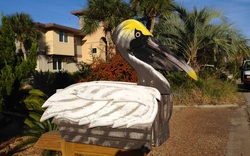
If there was an award for a creative mailbox, this would get one.

A Tiki hut bus stop?
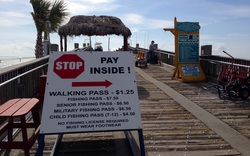
A government built pier that charges a fee to walk on it. If I was the king, a proclamation would go out: The taxpayer pays once.

This looks like something out of "Men in Black" and is a transporter for aliens. Perhaps, that explains everything about Florida?

How a green channel marker looks white

What a cute boat dog and so well behaved. It has not moved in hours. Closer look, it is not real. Is it a chick magnet or maybe it just keeps the birds away?

Complete instructions from safety to courtesy.

Does the building of this roofing company inspire confidence in their work?
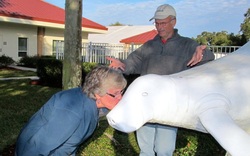
Laurie is a "manatee lover" much to Rich's chagrin.

Is this both fun and a contradiction?






